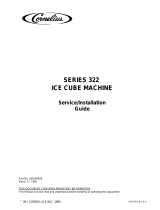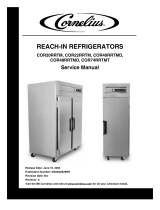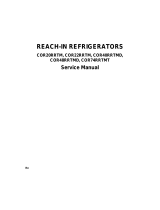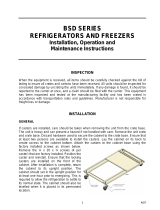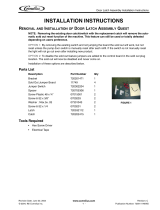
Reach-In Freezer Service Manual
© 2004, IMI Cornelius Inc. - 9 - Publication Number: 630460260SER
4. Install a new heater element. Be sure to use similar copper wire to install the new element tightly
against the coil. Note that there is a bend in the heater element along the center rear. This must
make good contact with the drain pan or baffle at the drain opening in order to work properly. If it
does not make good contact, the drain line will freeze up and the defrost water will overflow into the
food compartment during the defrost cycle.
Condensing unit
The condensing unit consists of the following parts:
• Compressor
• Condenser fan motor assembly
• Condenser
• Relay
• Starting capacitor (running capacitor on some models)
• Service valves. Most units have high and low side service valves, but in some instances there may be
only a low side service valve.
Some compressors have the mechanism mounted on springs inside the housing (referred to as internal
mounts) and others have the entire compressor body mounted on springs and rubber bushings (referred
to as external mounts) to absorb the vibration. In the latter case bolts run up through the springs and are
secured with a retainer nut. During shipping the nuts on these bolts are tightened to prevent the
compressor from moving and damaging itself or other parts. Before the cabinet is placed in operation,
these nuts must be loosened enough to allow the compressor to float freely on the springs so that
vibration will be absorbed by the springs.
Problems with the refrigeration system are usually due to failure of one of the components in the
condensing unit area. The service person should install a set of gages on the service valves to determine
the operating pressures. Compare these pressures to the specifications to determine the cause and
solution.
If there is an electrical problem, the service person should use a volt/amp meter, a watt meter, and a
continuity tester. An ohm meter can be used as a continuity tester.
A common refrigeration failure is a leak of some or all of the refrigerant. Because the leak can be very
small it can be very difficult to find. It usually develops on the high side of the system and only leaks when
the compressor is running. The condenser fan carries the refrigerant away making the leak difficult to
detect. If a leak detector does not find the leak, put a block of wood or a wad of rags against the fan blade
to keep it from turning while the compressor is running. This will cause the pressure to build up and make
the leak easier to find. This will not harm the fan motor or system if the fan blade is only stopped for a few
minutes.
The pick up hose of the torch should be passed back and forth over all tubing joints and over the entire
condenser very carefully. After the leak is found, repair it if possible. If it cannot be repaired, replace the
leaking part.
Whenever a leak has been located and repaired, the entire charge should be removed and a triple
evacuation procedure must be followed to be sure that all contaminants are removed. A good dryer of
proper size should be installed in the liquid line and a new charge of refrigerant put back in allowing extra
to compensate for the dryer.
After the cabinet has run for several hours, it should be rechecked to be sure the gas charge is correct
and the system is balanced.






















